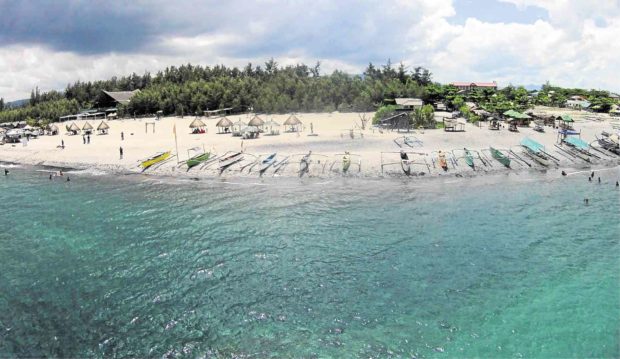
TOURISM BOOM The tourism industry of San Narciso, Zambales, has benefited from sand and lahar from Mt. Pinatubo, as sections of the town’s coastline have become friendlier to beachgoers. —REM ZAMORA
SAN NARCISO, Zambales — Over two decades ago, Mt. Pinatubo’s massive eruption dumped thick ashfall over 2,000 square kilometers in Luzon, altering the vast landscape of the provinces of Zambales, Pampanga and Tarlac.
The shoreline of San Narciso town in Zambales, however, has become an accidental beneficiary of that deadly fury unleashed by the volcano in 1991.
Mayor La Rainne Abad-Sarmiento has recognized the fourth-class municipality’s potential as a haven for tourists. This side of the West Philippine Sea is ideal for swimming or surfboarding, and other water sports.

“Sandbars cropped out of the tons of lahar, creating a new beach and extending the shoreline to about 100 meters more” La Rainne Abad-Sarmiento, San Narciso Mayor -NIÑO JESUS ORBETA
Rows of “agoho” trees against a backdrop of crystal blue seas greet solo wanderers, groups of travelers or families who love to spend a quiet day or two in the town, now known as Zambales’ surfing capital.
Favorite destinations
The beaches of San Narciso and nearby towns are the go-to destinations of people who love to enjoy a sparsely crowded shoreline.
Even before Pinatubo’s eruptions, San Narciso has been the prime destination of surfers and travelers, according to local guide Nestor Trinidad.
Thick ashfall, soaked and made heavier by rains, and mixed with mudflows (lahar) overran the coastline, Sarmiento said.
“Sandbars cropped out of the tons of lahar, creating a new beach and extending the shoreline to about 100 meters more,” she said.
In Barangay La Paz, lahar collected from the shores widened the coast.
The town boasts of some of the popular beach resorts in Zambales.
For one, the 7-hectare Crystal Beach Resort has been attracting local and foreign tourists. It features thatched nipa huts that offer shade, hammocks of all sorts hanging from trees, and picnic tables.
Surfboards of varying sizes are on display at the entrance, inviting guests to try surfing. Surfing instructors guarantee that the beach is safe for this sport.
Crystal Beach got its name from the glistening surface of both the sand and sea, whether in bright sunlight or under moonlight. It has a mix of modern native cottages, which can accommodate up to six people, and a barracks-style dormitory for up to 20 people.
Camping adventure
The beach area has also become a safe campsite for adventure seekers who are looking for affordable yet fun ways to spend their vacation.
Resorts also offer camping tents to guests. They can also set up their own tents.
San Narciso is fast becoming a favorite surfing spot in Luzon, not only because of its nearness to Metro Manila but also because of its natural waves that reach as high as 3.05 meters (10 feet), especially during surfing season starting in May.

